The Embassy of France in Bamako is the diplomatic mission of France to Mali. It is in Patrice Lumumba Square in Bamako, the capital of Mali. As of 2015 [update] , the French ambassador to Mali was Gilles Huberson.
The Embassy of France in Bamako is the diplomatic mission of France to Mali. It is in Patrice Lumumba Square in Bamako, the capital of Mali. As of 2015 [update] , the French ambassador to Mali was Gilles Huberson.
Bambara, also known as Bamana or Bamanankan is a lingua franca and national language of Mali spoken by perhaps 15 million people, natively by 5 million Bambara people and about 10 million second-language users. It is estimated that about 80 percent of the population of Mali speak Bambara as a first or second language. It has a subject–object–verb clause structure and two lexical tones. The native name bamanankan means "the language of greats, people who reject the religion of Islam", as opposed to speakers of Dyula, who are Muslim.

Bamako is the capital and largest city of Mali, with a 2009 population of 1,810,366 and an estimated 2020 population of 2.71 million. It is located on the Niger River, near the rapids that divide the upper and middle Niger valleys in the southwestern part of the country.
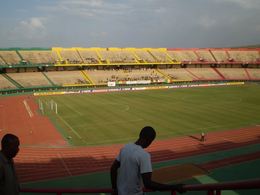
Stade du 26 Mars is located in the southern neighborhoods of Bamako, Mali. It serves as a home ground for domestic football club Stade Malien and is the national stadium. It has a capacity of 50,000 as an all-seater stadium. Built in 2001, it is named for the date of Martyrs' Day (Mali), a national commemoration of 26 March 1991 Bamako uprising which overthrew the dictatorship of Moussa Traoré. The stadium, which is built by China Overseas Engineering Group, served as a venue for 2002 African Cup of Nations.
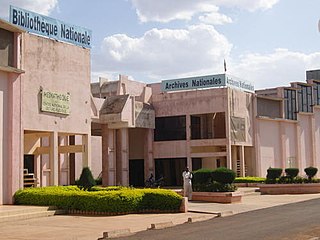
The National Library of Mali is located in Bamako, Mali.

The Archdiocese of Bamako is the Metropolitan Archdiocesan See for the Ecclesiastical province which covers all and only Mali, yet depends on the missionary Roman Congregation for the Evangelization of Peoples.

Koulikoro Cercle is an administrative subdivision of the Koulikoro Region of Mali. Its seat is the town of Koulikoro, which is also the capital of the region. A major trade and industrial town on the Niger River, Koulikoro has been surpassed by Kati to the west as the largest town in the region. Also to the southwest, lying entirely within Kati Cercle but administratively separate, is the District of Bamako, which after independence was carved out of the middle of the region.
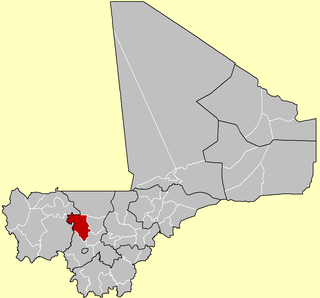
Kolokani Cercle is an administrative subdivision of the Koulikoro Region of Mali. Its seat is the town of Kolokani, which is also its largest settlement. It lies directly to the north of Kati Cercle. Also to the south, is the District of Bamako, which after independence was carved out of the middle of the Region. The cercle is further divided into communes.

Kati Cercle is an administrative subdivision of the Koulikoro Region of Mali. Its seat is the town of Kati, which is also its largest town. It lies at the southwest corner of the region, and completely surrounds the Bamako Capital District. Until the capital was hived off in 1977, the combined Cercle was called Bamako Cercle, with the capital city as its seat.

Dioïla Cercle is an administrative subdivision of the Koulikoro Region of Mali. Its seat is the town of Dioïla. It lies at the southeast corner of the region, and prior to 1977, it was combined with what is now Kati Cercle and the District of Bamako in the "Bamako Cercle", with the capital city as its seat.

The King Fahd Bridge of Bamako, Mali connects the older sections of the Malian capital to its broad suburbs on the south shore of the Niger River.

The Martyrs Bridge of Bamako, Mali connects the older sections of the city to its suburbs on the south shore of the Niger River. One of three road bridges across the Niger at Bamako, it is also known as the "Old Bridge". Opened in 1957 when Mali was under French colonial rule, it was renamed the Martyrs Bridge after independence in 1961. Martyrs Bridge connects two of the main avenues of the city. Avenue Fleuve, a broad boulevard enclosing the Square Lamumba which runs north towards the Presidential palace. From the south of the bridge runs Avenue de l'Unite Africain, the major route from the city centre south to Bamako-Senou Airport.
Korofina is a district of Bamako in Mali.
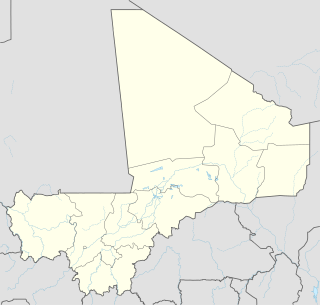
N'Gabacoro or N'Gabacoro-Droit is a small town and rural commune in the Cercle of Kati in the Koulikoro Region of south-western Mali. The commune covers an area of 103 square kilometers and includes the town and 6 villages. In the 2009 census the commune had a population of 15,153. The town of N'Gabacoro lies 18 km east of the Malian capital, Bamako.
In an attack on March 7, 2015, five people were shot dead and nine wounded in a restaurant on a busy street of Bamako, the capital of Mali. Two of those killed were Malians, and the others French and Belgian respectively.
Patrice Lumumba Square is a large central plaza in Bamako, the capital and largest city of Mali. The square has a life-size statue of its namesake, the Congolese independence leader Patrice Lumumba, a park with fountains, and a flag display. Around Lumumba Square are various businesses, embassies, including the French Embassy, and Bamako's largest bank.

The Sacred Heart Cathedral is located in Bamako, the capital of Mali it serves as the cathedral of the Archdiocese of Bamako.
The 2016 Nampala attack was an armed assault against a Malian Army base in the Niono Cercle subdivision of the Ségou Region of Mali on 19 July 2016, that left at least 17 government soldiers dead and 35 others injured. The Macina Liberation Front, al-Qaeda in the Islamic Maghreb and the ethnic Fula militant group 'National Alliance for the Protection of Fulani Identity and the Restoration of Justice' (ANSIPRJ) claimed joint responsibility.
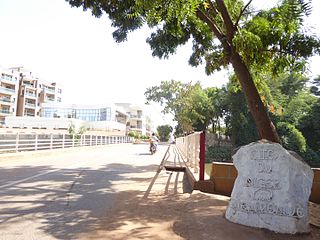
Cité Niger, also called "Cité du Niger" is a Bamako neighborhood and an island on the Niger river. The Cité du Niger is located in the Commune 2 of the Bamako district.
The following is a timeline of the history of the city of Bamako, Mali.